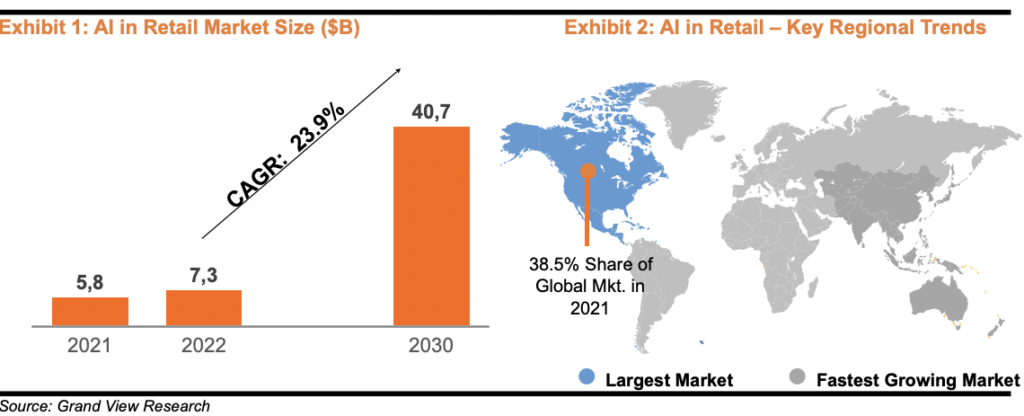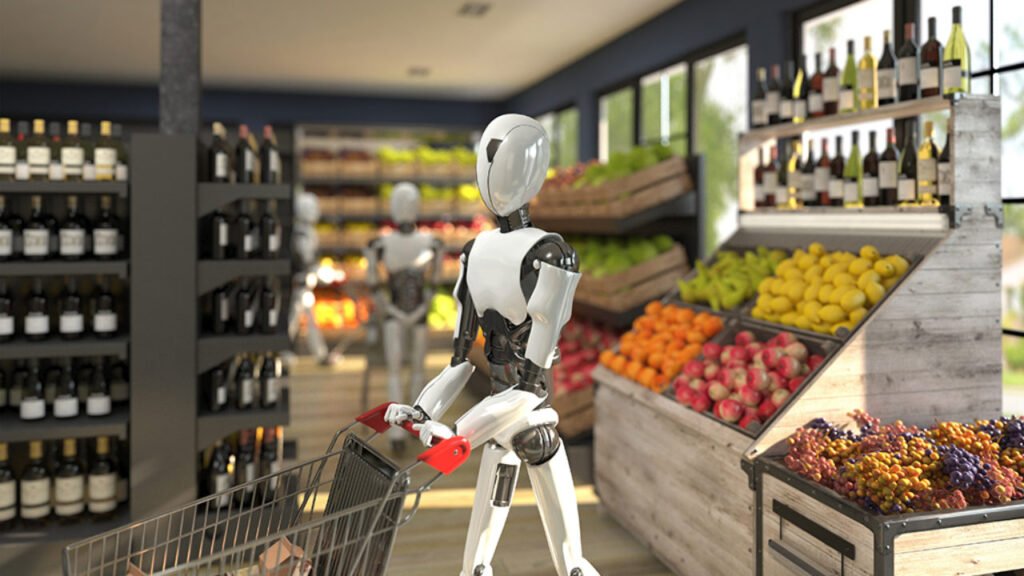AI & ML can be an answer to “Retail Apocalypse”?
Retail Apocalypse, a term used for the mass closure of brick-and-mortar retail stores, especially those of large chains worldwide, started much before COVID-19 mandated closings. Ecommerce was already making holes into retailer’s pockets, which was made even worse by the Coronavirus-induced shift in consumer behaviour. Currently, modern-day retail is at an inflection point as retailers face struggling physical storefronts, massive debt, and inefficient operations, among other issues. To improve operational efficiency and increase footfalls, a number of retail giants have started leveraging the latent power of Artificial Intelligence (AI) and Machine Learning (ML). This blog focuses on how AI and ML are assisting retailers fight some of the inherent causes of the retail apocalypse (or are they really?).
Gear up for an extended period of high growth….
AI in retail is estimated to witness a 23.9% CAGR between 2022 and 2030, to reach $40.7B in 2030. While North America dominates with a 38.5% share of the global market, Asia Pacific is likely to witness the fastest CAGR of 31.6% during 2022-30.
Rising investments and R&D in AI start-ups are estimated to propel the next growth phase. Retailers have truly understood the benefits of AI and big data analytics in transforming everything from customer experience to business operations. Moreover, supportive policies from several Governments (such as the US executive order on American leadership in AI, China’s Next Generation AI Development Plan, and AI Made in Germany) are also likely to provide wings to the sector.

So, what does AI & ML offers to consumers?
Imagine you walk into your favourite storefront and are greeted by a humanoid robot. The intelligent service robot is ready to advise you on the shopping as soon as you walk through the door. Based on your past purchases and behaviour, it generates personalised recommendations for you (here comes ML into the picture). There is more, a smart cart enriches your shopping experience and checkout-free platforms avoids you from standing in long checkout queues. Moreover, to make you visit the store, again and again, the retailer has a personalized loyalty program in place. In a nutshell, AI & ML has offerings right from the moment you enter the store to check out and then induce you to visit the store again.
Amazon Go was an early adopter of the technology
In Seattle, Washington, one can find a one-of-a-kind disruptive retail store, Amazon Go, a concept that has gained immense popularity after launching its first Beta store way back in 2018. With a grab-and-go retail model, Amazon Go facilitates frictionless shopping. The consumer just needs to install the app on their smartphone, take up an item from the shelf, and leave the shop. The product gets automatically added to the customer’s cart and the amount is debited from the Amazon account. This is just one example of how AI & ML is being used to enhance the in-store customer shopping experience. Other key uses include service robots, inventory management, and analytics, among others

Amazon Go was an early adopter of the technology
In Seattle, Washington, one can find a one-of-a-kind disruptive retail store, Amazon Go, a concept that has gained immense popularity after launching its first Beta store way back in 2018. With a grab-and-go retail model, Amazon Go facilitates frictionless shopping. The consumer just needs to install the app on their smartphone, take up an item from the shelf, and leave the shop. The product gets automatically added to the customer’s cart and the amount is debited from the Amazon account. This is just one example of how AI & ML is being used to enhance the in-store customer shopping experience. Other key uses include service robots, inventory management, and analytics, among others
COVID-19 expedited the adoption of AI & ML…
The Coronavirus pandemic changed consumer shopping behaviour and preferences. This disrupted the legacy retail operating model and forced major retailers to embrace the omnichannel business model to retain customers. A survey from Jabil, a manufacturing solutions provider (including robotics and warehouse automation for retailers), reflected that on average, companies with a strong omnichannel models enjoy customer retention of over 90% as compared to a third for firms with weak omnichannel engagement.
As retailers transform their operations to embrace an omnichannel strategy, inventory management (stock-outs and overstock) and predicting demand based on consumer behaviour become increasingly difficult. To counter these challenges, they are resorting to various AI & ML-powered technologies (such as stock-taking robots, big data analytics, and computer vision cameras). Thus, the digital transformation in retail (including the adoption of AI & ML), which witnessed a breakneck pace during the pandemic is still continuing and currently, AI & ML is considered no longer a luxury, but a necessity for retailers.
AI & ML provides deep customer insights
AI in retail is empowering companies with high-level data and information that is leveraged to improve operational efficiency and explore new business opportunities. Through advanced AI analytical capabilities, retailers convert raw data (collected through various IoT devices and other sources) into actionable insights, which are used to personalize the customer experience and make valuable connections with their customers. Personalized products & services enhance consumers’ willingness to pay by up to 16%.

Thanks to AI & ML, retailers can now analyse how their valued customers are interacting with products in the store – such as picking it up and putting it in a basket, or putting it back down and then moving it to another shelf. The insights generated assist retailers handle critical business operations such as inventory management, as well as spotting suspicious behavior and monitor theft.
… and there is much more than just providing customer insights
Below are some of the other prominent trends observed in AI & ML in the retail space.
- AI-powered cashier-less technology is setting the pace for futuristic retail stores: Pioneered by Amazon, this technology has the ability to provide a frictionless shopping experience to customers
- Virtual fitting rooms improve sales and customer retention: The AI-powered virtual fitting rooms have become popular with retailers, with a key player such as Carrefour, Walmart, and Macy’s already embracing the technology
- Conversational Commerce (CC) provides personalized and smoother customer engagement: The use of CC is expected to rise, with ~70% of chatbot conversations likely to be related to retail by 2023. Further, the use of emotional AI technologies, which can deep dive into the subconscious preference of customers and use emotional insights to make chatbot conversations more contextual, is set to rise in future
- Robots are everywhere, from warehouses to shopfronts: The pandemic has induced major retailers (such as Kroger, Carrefour, and Tesco) to accelerate robotics deployment. Robots from Simbe Robotics (Tally), Bossa Nova, SoftBank Robotics (Pepper), Fellow Robots (LoweBot), Zippedi, Pringle Robotics (KettyBot), and InGen Dynamics (Aido) can be seen scanning shelves for missing inventory or being at the storefront as a personal shopping assistant

The final verdict – Can AI & ML really solve the “Retail Apocalypse” issue?
Well, there are four key reasons for the retail apocalypse: i) a shift in consumer habits towards online shopping; ii) oversupply; iii) a shrinking middle class; and iii) poor retail management. Out of these, AI & ML can definitely control poor retail management through predictive analytics, better inventory management, and automation. Further, personalized product offerings and loyalty management program has the potential of luring customers to visit the store again and again. Also, innovative concepts including frictionless shopping and AR/VR are likely to make shopping at stores more enjoyable and satisfying. Thus, AI is definitely helping retailers bring customers back to the store and retain them.
In a nutshell, the forward-looking retailers who are embracing AI & ML will not only survive but also thrive in the challenging business environment. Having said that, store rationalization will continue to be the prevalent market phenomenon. In Apr’22, UBS expected 40-50K store closures in the US over the next 5 years. Interestingly, the estimate is down from the 80K closures it previously forecasted. This should be seen as a silver lining for retailers.

Sources:
- https://www.grandviewresearch.com/industry-analysis/ai-retail-market-report
- https://www.jabil.com/blog/eight-retail-4-0-trends-driving-the-industry.html
- https://www.wizeline.com/ai-trends-shaping-the-future-of-retail-2022-edition
- https://www.linkedin.com/pulse/rise-conversational-ai-retail-bernard-marr
- https://www.wizeline.com/ai-trends-shaping-the-future-of-retail-2022-edition
ComCap has also published its Automotive Retail Software Market Activity Report that covers key themes, market landscape, recent transactions, and a list of the most active investors within the sector. Please find our Auto Report here.
Copyright © 2022 ComCap LLC member, FINRA & SIPC, All rights reserved.
About ComCap
ComCap is a premier investment bank focused on M&A and capital raising services in the digital commerce, marketing, consumer, and payments ecosystems. Founded in 2012 in San Francisco, California, ComCap works with clients globally to ensure the achievement of their strategic priorities. For more information, please visit https://comcapllc.com.



